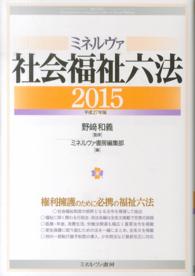- ホーム
- > 洋書
- > ドイツ書
- > Humanities, Arts & Music
- > Philosophy
- > 20th century, 21st century
Full Description
Phenomenological approaches to sounds, noises, voices, and music traditionally privilege methods that center visual perception. This book aims not only to phenomenologically describe sonic environments, but also to develop an audition-centered phenomenological methodology to enable this task. "Sonic environment" is this book's term for the acoustic shape of human life-environment, which is multisensory and does not exclude visual, tactile, olfactory, and gustatory sensations connected with sounds or their sources. Sonic environments (in so far as they are lived) are not composed of separate sounds, but created by "sonic phenomena" - i.e., lived (real or imagined) experiences with sounds, noises, voices, and music. Just as phenomenology traditionally privileges the visual over the audio, phenomenology thematically prefers listening to a voice or a music over less articulated sonic experiences (i.e., sounds without an obvious meaning, melody, or rhythm).In this respect, the book not only provides missing phenomenological descriptions of sonic environments, but also redefines phenomenological methodology with respect to acoustic perception.
Contents
Introduction.- 1. Phenomenology.- 1.1. Phenomenological Methodology in Sonic Research.- 1.2. Active/Passive, Embodiment, Intersubjectivity.- 1.3. Phenomenology and Sound-studies.- 2. Topological Phenomenology of Sonic Environments.- 2.1. Space, Place, Dimension.- 2.2. Localization, Displacement.- 2.3. Environment, Soundscape, Acoustic Space.- 2.4. Echo, Resonance, Vibration, Reverberation.- 3. Perception.- 3.1. Hearing and Listening.- 3.2. Multisensory Perception.- 3.3. Sonic Immersion.- 4. Constitutive Elements of Sonic Environments.- 4.1. Sound. Soundwaves.- 4.2. Rhythm.- 4.3. Voice.- 4.4. Natural vs. Technological Elements.- 4.5. Others. Sonic bodies.- 5. On and Beyond the Horizon of Auditory Experience.- 5.1. Disruptions. Disharmonies. Transitions.- 5.2. Noise.- 5.3. Silence. Deafness.- 6. Composition of Sonic Environments.- 6.1. Music.- 6.2. Film.- 6.3. Games. Sonic interfaces.- 7. Conclusion.- 7.1. Sonic phenomenology.- 7.2. Acoustic Sense of Place.








